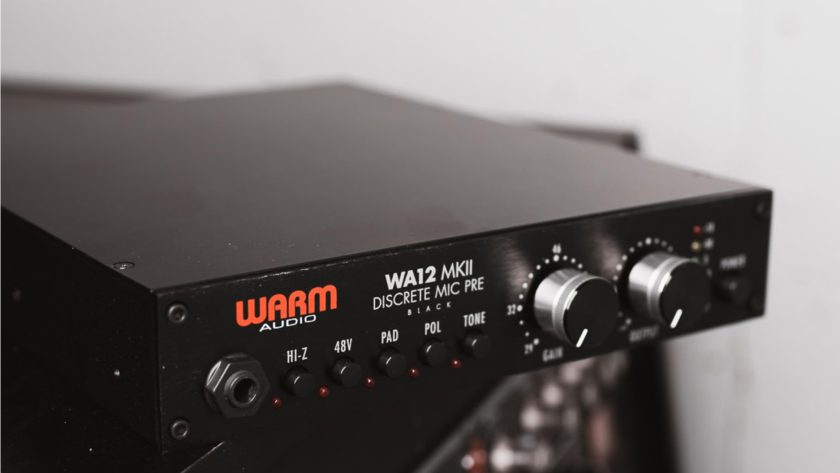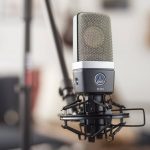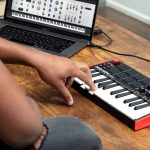In this review we feature the best microphone preamps that are great for boosting your microphone signal to line level and getting better clarity and detail in your audio recordings. A microphone preamp is a great choice if you are using a high-quality condenser microphone such as the Neumann TLM 103 condenser microphone that requires more power gain to bring the signal to line level, and your audio interface does not have enough gain to produce the level of high quality clarity and detail in your recordings. Some of these mic preamps are also great for adding tone or warmth to the recordings, making your vocals sound much more engaging and deep.
Having said that…
Do you really need a dedicated mic preamp?
If you are a beginner starting out with your home recording studio, the answer is no – you don’t usually need a dedicated mic preamp as your audio interface will come with line-level mic inputs that supply phantom power (+48V for condenser mics) and enough signal gain for your microphone. To illustrate, a beginner-friendly audio interface such as the Focusrite Scarlett Solo 4th Generation audio interface or the PreSonus AudioBox iTwo interface will come with Class A preamps and a +48V phantom power for condenser microphones, so you don’t need to get an additional preamp with your microphone. You can simply plug in your microphone to these audio interfaces using an XLR cable and the interface will supply power to the condenser microphone.
When do you need an dedicated mic preamp?
You should only get a dedicated mic preamp if you want to rely solely on the mic preamp’s gain and phantom power (and therefore bypassing phantom power from your audio interface – we will demonstrate how you can bypass phantom power from the audio interface below). This means that your microphone will rely solely on your dedicated preamp for gain amplification. We only recommend this if you using a high-end condenser microphone that you need to drive a lot of power to, such as a Neumann mic.
A dedicated preamp can make the recordings sound more focused and detailed, and they sound much better than a built-in audio interface preamp especially when it comes to professional recording studios. If you are looking to add vintage warmth to your recordings or if you want to add depth to recording music instruments, a dedicated preamp with proper gain amplification can also help to make your recordings sound more robust and detailed.
How to connect a mic preamp to an audio interface?
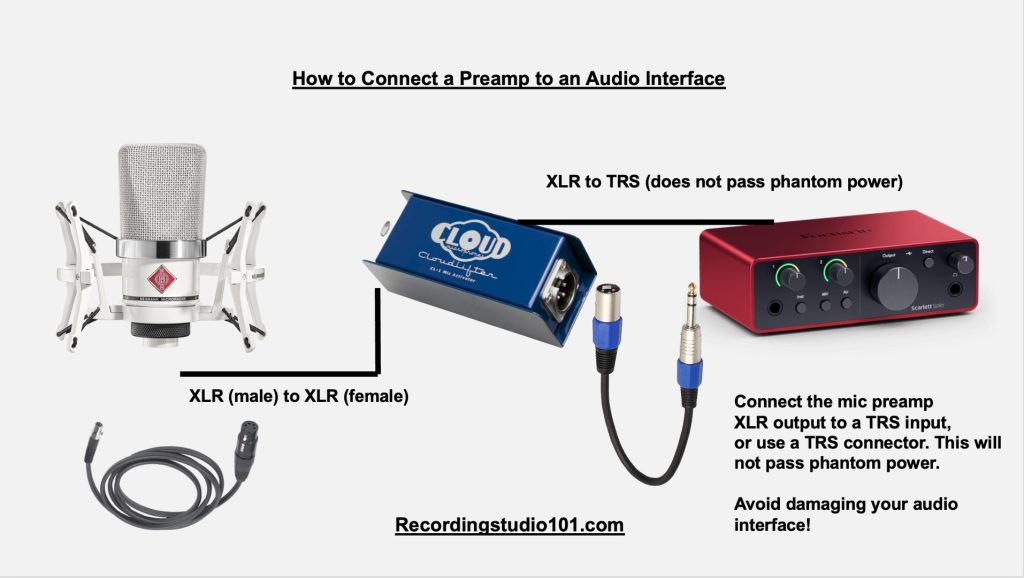
To connect a mic preamp to an audio interface, you will need to use a XLR to TRS cable (see diagram above). The reason why we use a TRS connector to the audio interface (and not XLR to XLR) is to prevent phantom power from the audio interface from flowing “back” into the preamp and potentially damaging both the preamp and your microphone. To summarize how the connection works:
- Microphone to preamp: XLR (male) to XLR (female) connection
- Preamp to audio interface: XLR to TRS (you can also use a TRS connector)
- Audio interface to computer: Interface Line-output to USB
This configuration is VERY important to ensure that you are not passing phantom power between the preamp and the audio interface, and thereby overwhelming your preamp or microphone. Make sure that you use a proper XLR to TRS cable or a TRS connector with your audio interface line-in to prevent this from happening.
Here are some of the best mic preamps that we recommend for adding warmth and depth to your condenser microphone.
1. Cloudlifter CL-1 Mic Activator Preamp
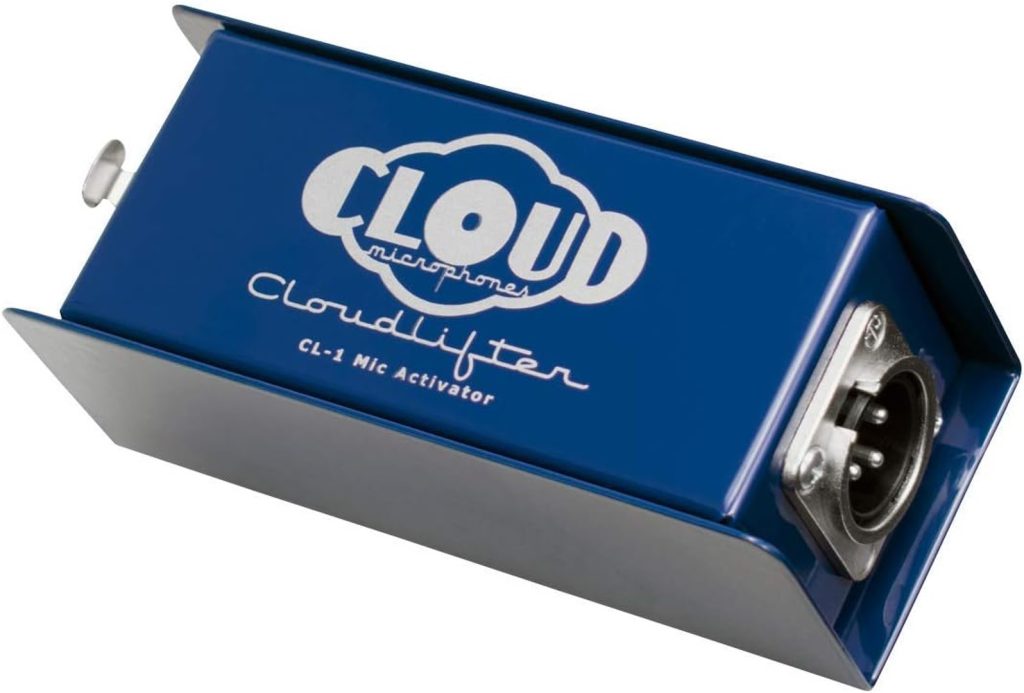
A simple and easy to use mic preamp…
The Cloudlifter CL-1 Mic Activator Preamp is a really good microphone preamp for home recording studios and professional recording. It provides a significant gain increase of up to +25dB, utilizing Phantom power without passing it onto the microphones themselves. This feature is particularly beneficial for passive mics, as it reduces unwanted feedback while maintaining the natural sound characteristics of the microphone. The CL-1 mic preamp comes with a single XLR input and output and is very simple and easy to use, and can be used with a wide variety of microphones including ribbon and tube mics.
The Cloudlifter CL-1 has the ability to provide a substantial clean gain boost while preserving the original sound quality of the microphone. This makes it ideal for use with ribbon and dynamic microphones, which often require additional gain. However, one limitation is its lack of adjustable gain settings, making it a less versatile choice for situations where varying levels of gain are required.
When compared to other microphone preamps, the Cloudlifter CL-1 is able to provide clean gain without any sound coloration and noise. It uses discrete JFET circuitry, free from transformers, capacitors, and resistors, which contributes to its ability to deliver a transparent gain boost. This design contrasts with other preamps that might use more complex circuitry or offer additional features like EQ or compression. I really like using this microphone preamp to record vocals and guitar as it preserves the natural sound of your microphone.
I highly recommend the Cloudlifter CL-1 preamp due to its ability to improve the quality of recordings with low-output microphones. It’s particularly useful for podcasting, live streaming, and radio broadcasts, where you might need a boost in vocal clarity. The microphone is compatible with a wide range of microphones including condensers and dynamic mics, and does not introduce phantom power which is an added plus. Overall, it’s a really good mic preamp to get especially if you want to see instant noticeable gain in vocal recordings.
2. Triton Audio FetHead in-Line Microphone Preamp
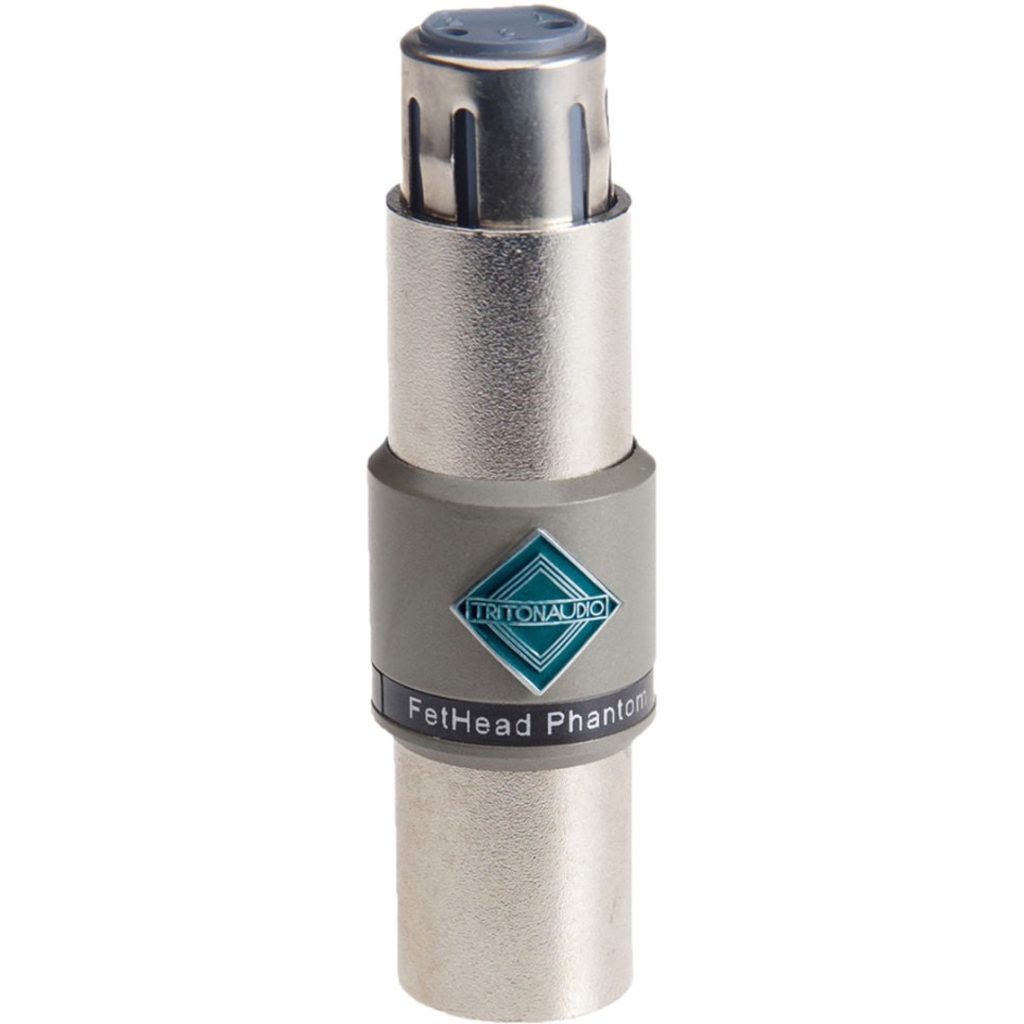
Another simple in-line mic preamp that sounds great…
The Triton Audio FetHead in-Line Microphone Preamp is a compact, low-noise preamp designed to improve the performance of both dynamic and condenser microphones. It uses a low noise Class A JFET amplifier and it provides up to 27dB of clean boost which enhances the signal quality significantly. This device is particularly effective in boosting the signals of microphones that require more gain, like the Shure SM7B or the Sennheiser MD441 without introducing additional noise or coloration. If you are looking for a simple and effective mic preamp, the Triton Audio Fethead comes highly recommended.
Like the Cloudlifter CL-1, I really like how easy it use to use the Triton Audio FetHead. It attaches directly to an XLR-equipped microphone or can be placed anywhere in the signal chain between the microphone and preamp or mixer. Its rugged metal chassis houses balanced female XLR input and male XLR output, making it durable for both studio and on-the-go use. Additionally, the FetHead is designed to protect delicate ribbon microphones by using phantom power for its circuitry without passing it to the microphone, so you don’t have to worry about the mic getting damaged by the preamp.
Compared to other mic preamps, the Triton Audio FetHead is pretty decent budget option. For example, the Cloudlifter CL-1 provides a clean gain boost (around 25dB) but at a higher price point. Similarly, the McBoost provides a 25dB gain increase but is significantly more expensive. The FetHead stands out for its affordability and the substantial clean gain without any coloration.
I would recommend the Triton Audio FetHead for home recording studios for its ease of use. Its ability to provide a significant clean gain boost while preserving the natural sound of the microphone makes it a valuable tool for enhancing audio quality. The preamp’s compact size, ease of use, and robust build also make it a practical choice for smaller home recording studio setups where space and budget might be limited. The FetHead’s ability to improve the sound of microphones across a broader frequency range and it does not reflect phantom power which makes it great for using with condenser or ribbon mics.
3. Rodyweil Microphone Preamp
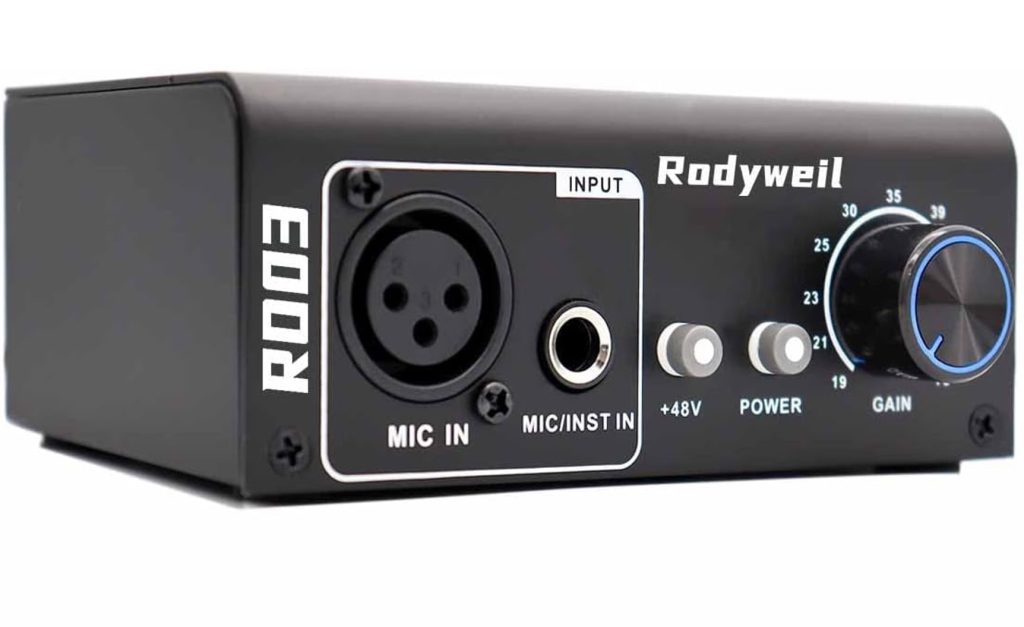
A really good mic preamp with +75dB gain…
The Rodyweil Microphone Preamp Mic Gain Booster is a versatile microphone preamp that can boost up signals by up to +75 dB, providing clean and transparent gain. The Rodywell preamp is compatible with a wide range of microphones including dynamic models like the SM7B, SM58, and 55SH, as well as condenser microphones. It comes with the standard 48V of phantom power to drive a condenser mic.
One of the key features of the Rodyweil preamp is its dual-channel input capability, allowing simultaneous boosting of one condenser mic and one dynamic mic. It supports 48V phantom power, catering to both dynamic and condenser mics. The preamp also includes XLR balanced output and 6.35mm stereo mic & line output, enabling connections with various audio devices like interfaces, mixers, consoles, and speakers.
This preamp is designed with a unique full balanced circuit, which produces super low noise and a clean sound without adding any coloration. This makes it ideal for vocal recording, podcasting, and live streaming. The black metal shell of the preamp not only adds to its durability but also effectively minimizes electromagnetic interference (EMC), contributing to its low noise performance. Additionally, the compact and lightweight design makes it convenient for portability and storage.
When compared to other microphone preamps, the Rodyweil preamp stands out for its high gain capability and dual-channel input feature. While other popular options like the Cloudlifter CL-1 provide up to 25dB of clean gain, the Rodyweil boasts a significantly higher gain of up to 75dB (which is a lot!). However, while the Cloudlifter CL-1 is specifically designed to enhance ribbon and dynamic microphones and provides protection against phantom power, the Rodyweil preamp extends its compatibility to both dynamic and condenser microphones, making it a more versatile choice.
Overall, the Rodyweil Microphone Preamp Mic Gain Booster is a great option for those in need of a high-gain, versatile preamp that is compatible with a variety of microphone types and suited for various recording applications. Its unique features like dual-channel input and full balanced circuit design make it a valuable tool for home recording studios and provides high-quality sound enhancement and flexibility.
4. dbx 286s Microphone Preamp
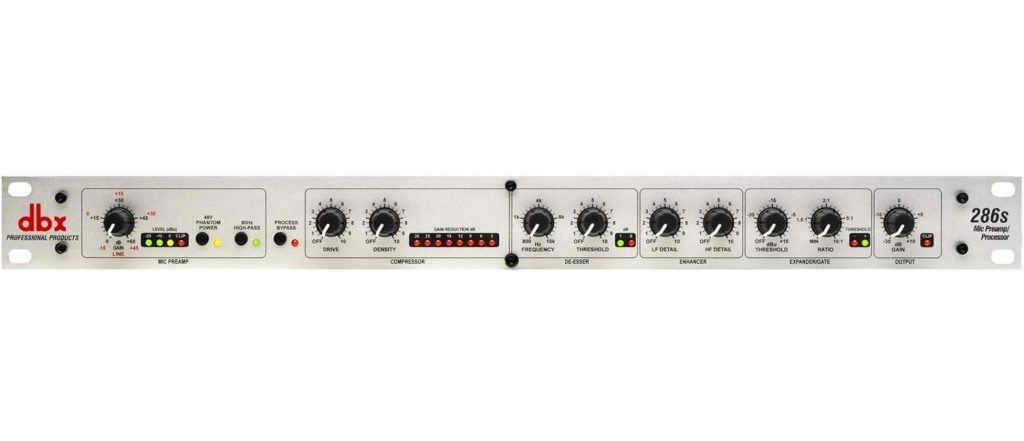
If you are looking for a channel strip together with a mic preamp…
The dbx 286s Microphone Preamp & Channel Strip Processor is a studio quality mic preamp and channel strip processor that brings together multiple vocal processing components into a single unit. It is primarily a one-channel preamp but features two inputs: a balanced XLR for microphones and a standard line input for instruments. These options cater to a variety of recording needs and it also supports classic dbx compression for better sound performance.
A key feature of the dbx 286s is its wide-ranging input gain control, with a gain range from 0 to +60 decibels for microphone inputs and -15 to +45 decibels for line inputs. It also includes switchable +48V phantom power and an 80Hz high-pass filter, which helps eliminate low-frequency disturbances like rumble or wind noise. The unit is also equipped with dbx’s classic OverEasy compressor, which works to smooth out acoustic tracks or add that sought-after vocal punch.
In terms of sound shaping and control, the dbx 286s provides a frequency-tunable de-esser to reduce sibilance and high-frequency distortion, alongside an enhancer that boosts detail and definition in both high and low frequencies. There’s also a noise gate/expander which works great for managing unwanted background noise and provides a cleaner signal.
I would recommend the dbx 286s preamp if you need more processing capabilities – it’s not a simple plug and play like the Cloudlifter CL-1. The dbx 286s provides a broader range of processing tools, including compression, de-essing, and noise gating, making it more of an all-in-one solution for vocal processing and comes with a tonne of features that you won’t normally get with a standard mic preamp.
If you are looking for a higher-end preamp with tonnes of processing features, the dbx 286s is an excellent choice due to its compactness and the array of features it provides. It serves not only as a quality preamp but also as a channel strip processor, providing a range of controls for fine-tuning your audio. Its ability to manage different aspects of sound shaping and noise control makes it great for recording studios and we highly recommend them.
5. Warm Audio WA12 MKII Mic Preamp
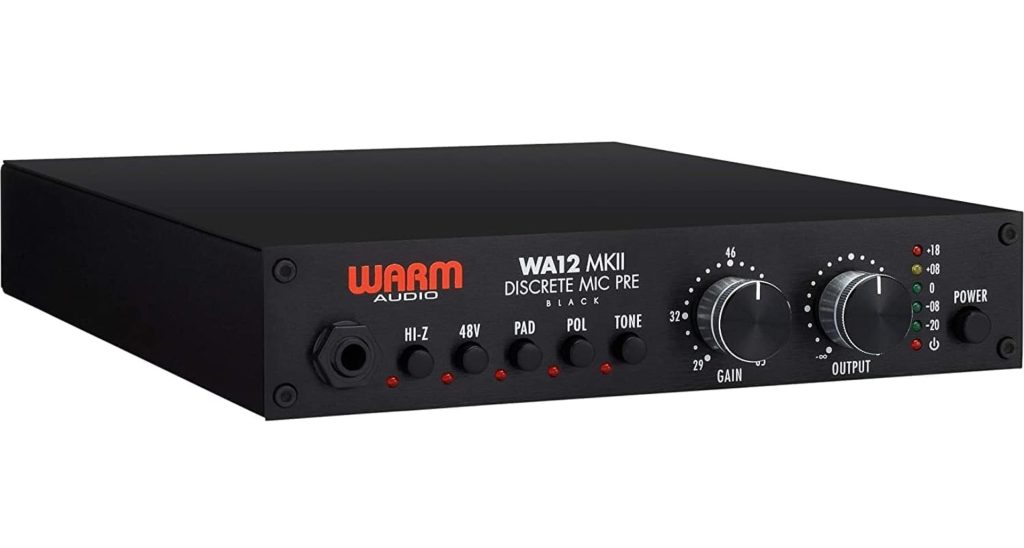
A versatile preamp with instrument DI…
The Warm Audio WA12 MKII is a single channel microphone preamp with DI and XLR balanced (and unbalanced) outputs, making it a versatile preamp for home recording studios. This preamplifier provides a fully discrete signal path which ensures a clean and uncolored sound. The unit is equipped with custom USA CineMag transformers which are known for their quality in audio signal processing, and it provides an overall warm and rich sound.
One of the key features of the WA12 MKII is its variable impedance input, which includes a unique ‘Tone’ button. This button allows users to switch the input impedance between 600Ω and 150Ω, providing flexibility in matching the preamp with different microphones and thereby altering the tonal characteristics of the sound. However, engaging the Tone button also results in a slight level change, which can make direct comparisons between settings a bit challenging but still provides a perceptible tonal change, particularly with dynamic mics.
In comparison to other preamps like the Golden Age Project Pre73, the WA12 provides a different sonic character. While the Pre73, a Neve 1073 clone, is known for its own distinct sound, the WA12 is described as having a thick, rich sound with a vintage character, especially beneficial for electric bass and guitars. The WA12 also comes with 71dB of gain, which is higher than many plug and play preamps.
For home recording studios, the Warm Audio WA12 MKII is a solid choice. Its high-quality components and the ability to add character to recordings make it well-suited for various applications, from vocals to instruments. This preamp also includes both XLR and 1/4″ TRS inputs and outputs which adds to its versatility. While its external power supply and step-gain control contribute to its ease of use, some users might find the minimum gain level (over 29 dB) to be on the higher side for low-gain applications, often necessitating the use of the -20dB pad.
6. Behringer ADA8200 Microphone Preamp
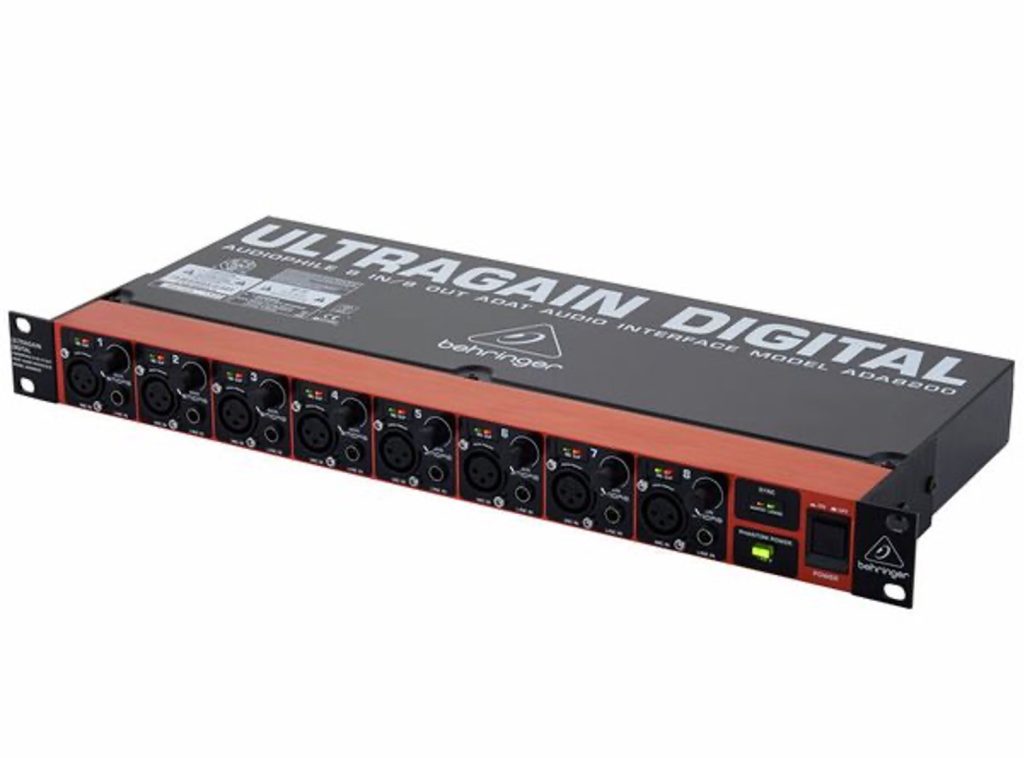
If you are looking for a multi-channel mic preamp…
The Behringer ADA8200 is a professional 8-channel microphone preamplifier and A/D converter, and comes with ADAT optical output for higher performance audio recordings. It features eight MIDAS-designed mic preamps which feeds into high-performance Cirrus Logic converters. This combination provides clean and clear signal conversion throughout the entire process.
One of the notable aspects of the ADA8200 is its clear and clean preamps which do not add any character to the sound. This means what you put in is what you get out, making it a good choice for those seeking an unaltered signal path. The converters perform decently, and the unit holds up well under various levels of gain without noticeable clipping or distortion, except when pushed to extremes, as you would expect. The ADA8200 has been noted to pass the ‘bluegrass torture test’, revealing the mid-range qualities of the equipment and providing a bit of an edge when pushed, which can be desirable in certain sound contexts.
In terms of comparisons with other microphone preamps, the ADA8200 works especially well if you are recording in a band and need to amp multiple mics at one go. While it doesn’t feature some of the additional capabilities found in higher-end models such as impact sound filter, phase rotation, or pre-attenuation, I found this preamp to be very simple and easy to use (it is essentially plug and play, but with 8 channel inputs). Its maximum input level of +6 dBu at minimum gain doesn’t offer a huge headroom, meaning it might not be the best choice for sensitive condenser microphones near loud sources. This preamp is also limited to 44.1kHz and 48kHz sample rates.
Overall, the Behringer ADA8200 is a really good 8-channel preamp for those who want more preamp inputs. It’s particularly useful for expanding the input capability of an existing audio interface, offering eight additional channels through an ADAT interface. The ADA8200’s back panel includes eight analog line outputs in XLR format and digital I/O on ADAT optical, allowing for maximum compatibility and versatility in various studio setups.
7. Behringer MIC300 Audiophile Tube Preamplifier
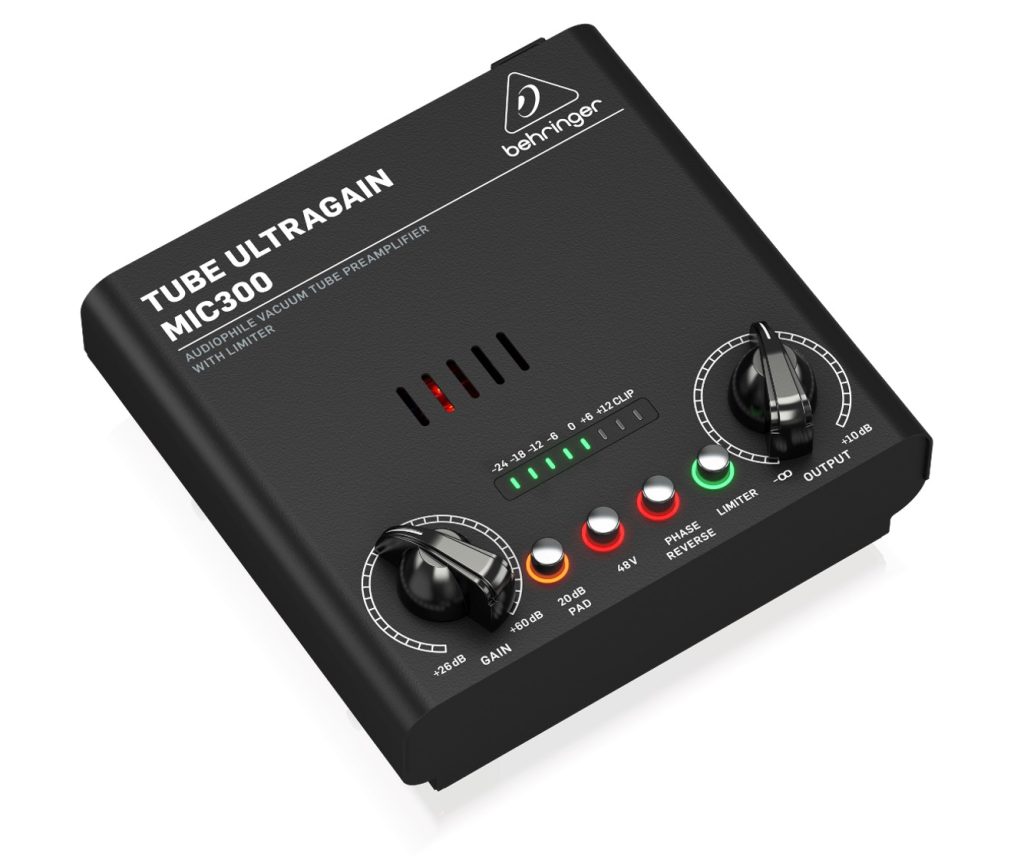
A really good mic tube preamp for those on a budget…
The Behringer MIC300 Audiophile Vacuum Tube Preamplifier is a single-channel preamp designed for studio-grade condenser microphones, instruments, and line-level sources.- it also comes with a limiter to control the sound quality and prevent clipping. This unit is known for its hand-selected 12AX7 vacuum tube with UTC technology, which provides exceptional warmth and low noise. The MIC300 also comes equipped with a sophisticated output limiter to prevent clipping of the output signal to ensure cleaner audio performance.
One of the primary advantages of the MIC300 is its high-end preamplification capability, which perfectly matches various studio or live recording setups. It ensures outstanding signal transparency when used as a high-end DI box. The preamp’s +48V phantom power, Phase Reverse switch, and 20 dB Pad provide significant flexibility in use.
I like the fact that the Behringer MIC300’s vacuum tube imparts a characteristic warmth to the sound, differentiating it from the solid-state preamps that dominate the market. For instance, solid-state preamps like the Focusrite Scarlett series are known for their clean and transparent sound but lack the tube coloration that adds a vintage warmth to the overall sound quality.
For home recording studios, the Behringer MIC300 audiophile tube preamp is a valuable addition especially for those looking to add tube warmth to their recordings without a substantial investment. This is a simple tube preamp that provides nice amplification for all microphones, instruments and line-level sources – it is specifically designed for studio-grade condenser mics to provide a more warm sound. While it may not match the performance of high-end tube preamps, its affordability and performance make it an excellent choice for those on a budget.
8. Presonus BlueTube DP v2 2-Channel Tube Preamp
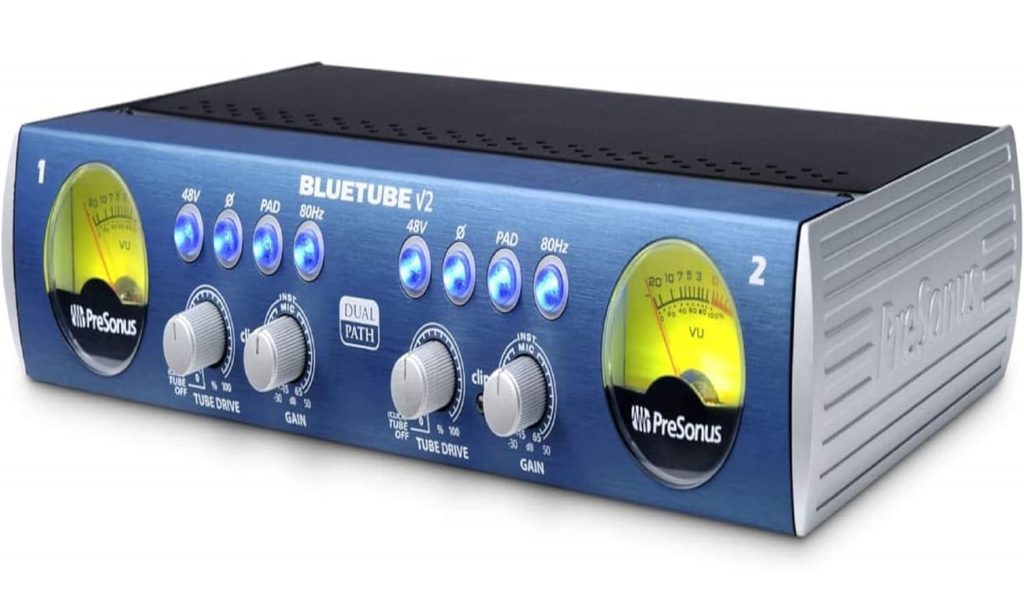
A very versatile preamp with vacuum tube and solid-state gain stages…
The Presonus BlueTube DP v2 is a 2-channel tube preamplifier that combines the clarity of solid-state preamps with the warmth and character of a tube stage. Each channel of the BlueTube DP v2 features Presonus’ Class A XMAX solid-state preamp, followed by a 12AX7 vacuum tube stage. This dual-path design allows users to blend the tube and solid-state sound characteristics.
I really like how versatile the Presonus BlueTube DP v2 preamp is for combo microphone and instrument inputs. It is equipped with both balanced XLR and unbalanced ¼-inch inputs and outputs, making it suitable for a wide range of microphones and instruments. The preamp provides up to 80dB of variable gain, which is substantial for various recording needs. Furthermore, it includes essential features like 48V phantom power, an 80Hz high-pass filter, a -20dB pad for managing hot input signals, and a polarity-reverse switch to adjust the mic inputs.
When it comes to sound quality, the BlueTube DP v2 provides clean and transparent amplification when the tube drive is disengaged. Once the tube drive is engaged, it provides everything from a subtle warmth to a rich tube saturation, depending on how much the drive is dialled in. This makes it flexible for recording different vocals and instruments and adding a tint of vintage warmth to the recordings.
The BlueTube DP v2 is housed in a compact 1/2U chassis, suitable for both studio and live settings. While its solid-state path exhibits a THD + noise figure better than 0.005 percent, engaging the tube can introduce up to 30 percent distortion, which is intended for musical coloration rather than accuracy. Its signal-to-noise ratio is greater than 95dB, comparable to what one might expect from a high-quality analogue console preamp.
Overall, the Presonus BlueTube DP v2 stands out for its dual-path design and it provides both the clean, transparent sound of solid-state preamps and the warm, harmonic richness of a tube stage. Its wide range of tonal possibilities combined with its versatile input/output options and high gain, makes it a suitable choice for home recording studios looking for a preamp that provides both quality and character.
9. Warm Audio WA73-EQ Mic Preamp
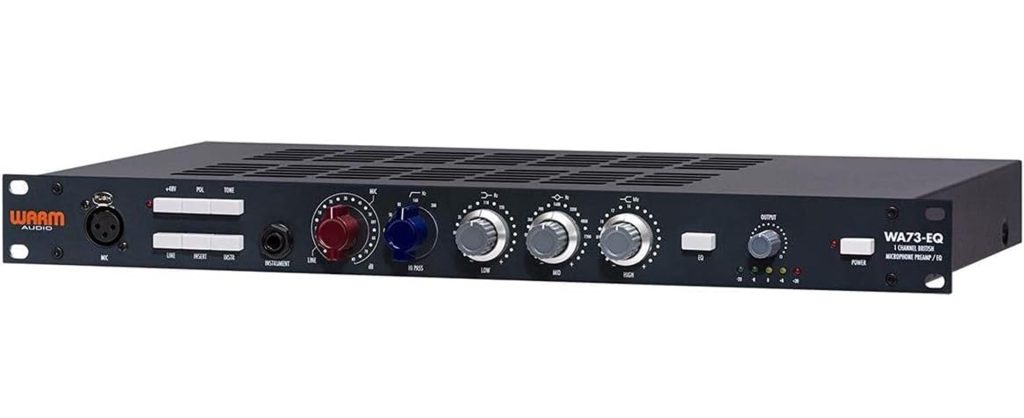
A clean 1-channel mic preamp with 3-band EQ…
The Warm Audio WA73-EQ is a single-channel microphone preamplifier that is designed after the iconic Neve 1073 preamp and comes with a 3-band EQ. This mic preamp provides a warm and colorful sound and is particularly suited for pop, rock, metal, and hip-hop vocals. The preamp features Class A solid-state circuitry and a fully discrete, transformer-balanced design, with UK-made Carnhill Transformers. This contributes to its ability to handle a wide range of microphones including low-output ribbons with up to 80dB of gain.
The WA73-EQ comes with a 3-band inductor-based EQ which provides low-band boost/cut options at 35, 60, 110, or 220Hz; mid-band boost/cut settings ranging from 360Hz to 7.2kHz; and high-band boost/cut at 10, 12, or 16kHz. An additional feature not found in the vintage 1073 is the high-pass filter, selectable at 50, 80, 160, and 300Hz, which provides more control over low-end frequencies. The EQ section is flexible, allowing you to shape your sound in various ways, whether it’s adding sheen, warmth, or detail to vocals and instruments. The unit also includes a Tone button, which changes the impedance of the input transformer, further shaping the tonality of passive ribbons and dynamic mics.
Compared with other preamps such as the legendary Neve 1073 preamp, the WA73-EQ has slightly harsher upper midrange and a less bright top-end compared to the Neve 1073. However, these differences are subtle, and the WA73-EQ can capture the essence of the classic British sound of the Neve 1073. This preamp feels well-constructed with solid components and a sturdy feel, although some of the knobs on the device have been noted to be wiggly and turn too easily when I tested them out.
For home recording studios, the WA73-EQ is a valuable addition due to its versatility and the really warm and vintage sound that it provides. It’s an excellent choice for serious home studio enthusiasts and professional sound engineers. The preamp’s ability to handle a wide range of input sources, its flexible EQ section, and its warm analog flavor make it a great option for those looking to add character and quality to their recordings with greater depth.
10. Black Lion Audio Auteur MK3 Microphone Preamp
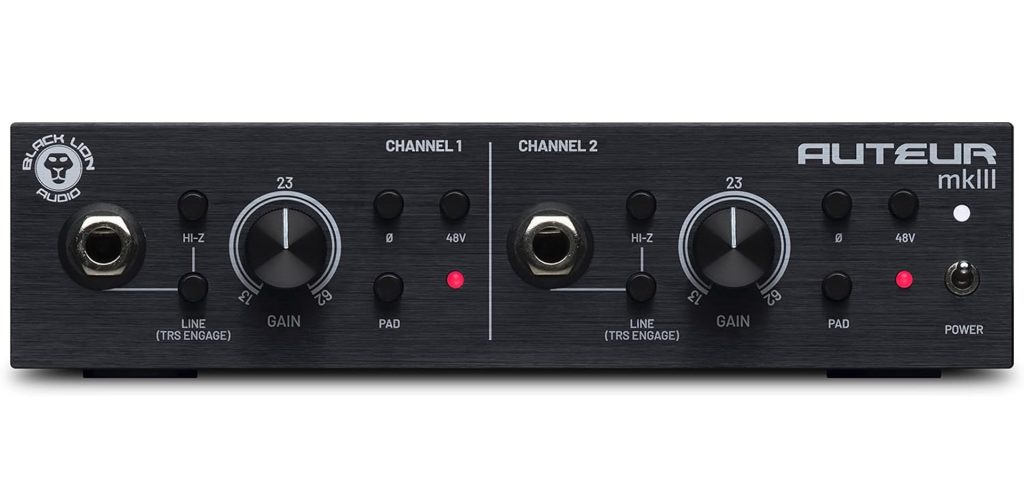
A very good 2-channel mic preamp…
The Black Lion Audio Auteur MK3 Dual Channel Microphone Preamp is a solid-state, 2-channel microphone preamplifier designed for home recording studios. Its IC-based front end provides a fast and transparent sound which is ideal for capturing the nuances of vocal and instrumental performances. The vintage-inspired, transformer-coupled output stage, featuring Cinemag transformers, provides a massive, colorful sound. This preamp is equipped with line and Hi-Z inputs, a -10dB pad, 48V phantom power, and polarity reverse for each channel, offering versatility in studio setups. It boasts a 62dB gain range and balanced TRS line outputs which caters to a variety of microphone types and recording scenarios. The preamp’s frequency response spans from 10Hz to 30kHz which covers a broad sonic spectrum. Additionally, it is designed for easy integration into a recording setup and is compatible with half-rack spaces (it also features removable rack ears for convenience).
In comparison to other microphone preamps, the Auteur MK3 shines with its combination of modern and vintage sound characteristics. It delivers a clean and clear sound with a touch of vintage warmth and coloration due to its Cinemag transformers. This differentiates it from preamps that either focus exclusively on a transparent, uncolored sound or those that impart a heavily colored vintage tone. For instance, the Golden Age Premier Pre‑73 Jr MkII and Fredenstein VAS provides a more straightforward sound profiles which are either more or less colored than the Auteur MK3, depending on the specific model. Black Lion Audio’s own B12A MkIII is another close competitor, but it leans more towards a vintage tone, in contrast to the Auteur MK3’s balanced modern-vintage sound blend.
I would recommend the Autuer MK3 if you are looking for a 2-channel mic preamp with nice transparent sound quality and subtle depth. The Auteur MK3 is particularly well-suited for home recording studios due to its compact size, ease of use, and the quality of sound it provides at its price point. It provides enough versatility to handle various recording tasks while still being simple enough for users who might not need the complexity of a larger studio setup. The Auteur MK3 is an excellent choice for musicians, podcasters, and voiceover artists who seek a high-performance preamp that adds character to recordings without overwhelming them with too much coloration.
Overall, this is a good mic preamp for both beginners and advanced musicians looking to add depth and transparency to the audio recordings, and I highly recommend them.
Next Steps
If you are thinking of getting a mic preamp, be sure to couple the preamp with a good quality condenser mic for recording vocals and getting the extra warmth and depth that the preamp has to offer. Most condenser mics will work with a basic audio interface that provides +48V of phantom power and gain, but if you are getting a high-end Neumann or Rode mic, a preamp would add warm and depth to the vocal recordings. You may also want to check out our guides on:
